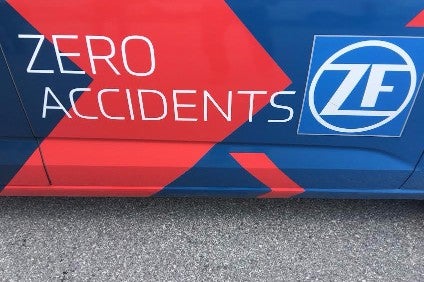
ZF says it will use the upcoming IAA in Frankfurt to push its integration with TRW as well as the Vision Zero concept of no accidents and emissions elimination.
The acquisition of the American supplier has powered ZF to become a giant with US$35bn sales at the same time as employing 138,000 staff and the colossal IAA to be opened by German Chancellor, Angela Merkel will see an integrated company showcase its technologies.
"IAA, the intention is to really position what is the new ZF," ZF corporate market board member, Peter Lake told just-auto at the supplier's recent Global Press Event at the Pachfurth Driving Camp near the Austria/Slovak border. "We have spent two years integrating and it is time we tell people how far we have come.
"Vision Zero will be at the heart of what we do – you will see a reflection of this [in Frankfurt]. Generally speaking, because we put together two companies that were complementary rather than competing, this has been a lot less painful and we don't think there has been any macho posturing on either side. There has been an attempt to find the best of both.
"At ZF, management was far-sighted and in 2013 they undertook a strategic review and looked at what the implications might be for for the future, to address megatrends. In preparing for that future the biggest step was the acquisition of TRW in 2015. The integration created a massive manufacturer, sales of US$35bn, EBIT of US$2bn; all of that when we spent more on capital and R&D.
"This economic strength enables us to pursue our strategy towards See, Think, Act. We are heading for zero accidents and zero emissions."

US Tariffs are shifting - will you react or anticipate?
Don’t let policy changes catch you off guard. Stay proactive with real-time data and expert analysis.
By GlobalDataPart of that See, Think, Act thinking and the Vision Zero concept, involves the supplier examining ways to reduce accidents using technology such as Wrong Way Inhibit designed to prevent incursions into entry instead of exit lanes and vice versa, while Driver Distraction Assist can help prevent loss of concentration at the wheel.
"The NTSB reported on average 360 people have been the victims of wrong way drivers in the US per year," added Lake. "In Germany alone, there were 12 people killed on roads because they went the wrong way; there are 2,200 accidents reported. This is a growing problem – this happens a lot.
"Around one in ten [accidents] is due to distraction. In 2010, it cased the loss of 350 lives in Germany. Behind the wheel people are distracted most of the time – 52% of the time drivers are in a distracted mode [while] 6% of the time they are using their mobile phones."
In Austria, the component manufacturer equally displayed technology to integrate and interconnect sensors, driver assist and occupant safety systems as the ramp-up to autonomous propulsion accelerates ever faster, although it is aware of the regulatory challenges this will bring, contributing where it thinks it can add.
"Our approach tends to be not one of an automotive lobbyist, but clearly we have an expertise in the industry and we provide input when asked," noted Lake. "For example, if NHTSA develops its thinking, we might be asked to consult, which we do and provide input.
"While the exact road is not entirely clear, the compass direction is and it is a question of when rather than if we can have levels of electrification and autonomous in vehicles. The direction will be inevitable.
"Connectivity and e-mobility are two of the major items to arise from that thinking and in both of those areas, ZF can provide some areas of support. Increasing connectivity brings together the IT industry and Tier 1s and here we see a melding between horizontal and vertical."
ZF has been examining in detail the 'last mile' concept of transport for delivery vehicles for example and has sponsored research by institutions to develop thinking, as well as working on fully-electric bus and lorry transmissions for use in cities.
"When it comes to delivery vehicles and maybe even vehicles that rely on micro-mobility solutions, we are positioning ourselves to be able to support that in the future," added Lake.



